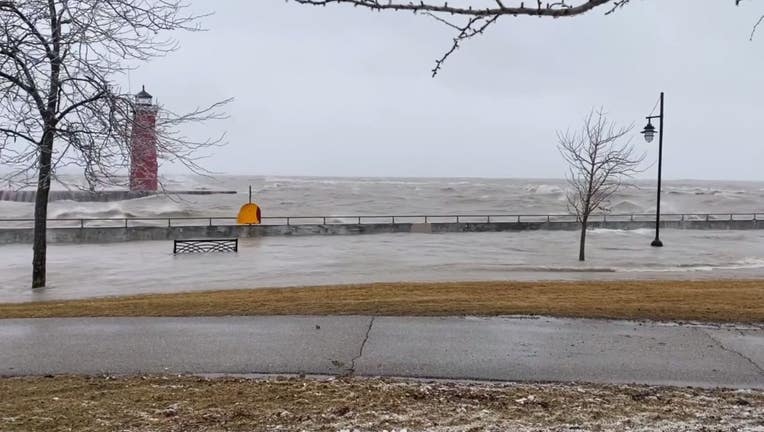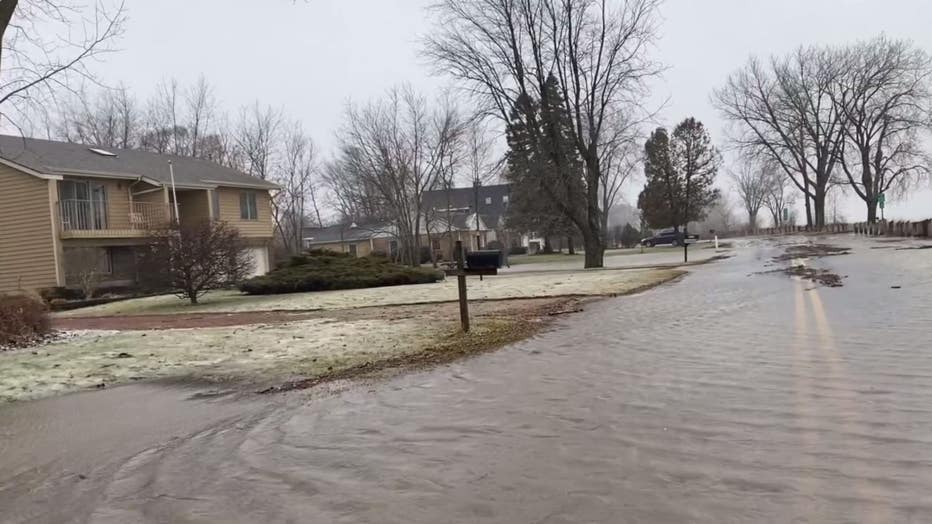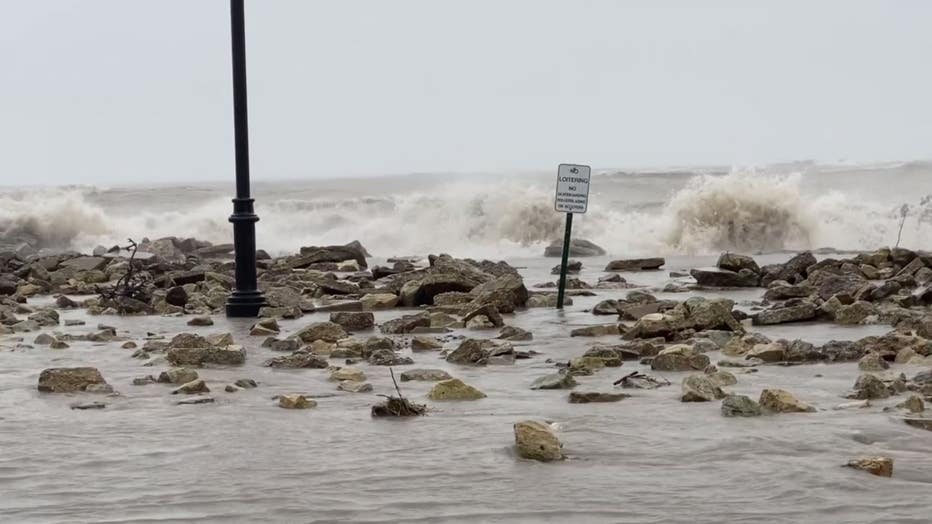High water levels are wreaking havoc in the Great Lakes, swamping communities

Lake Michigan flooding in January 2020 at the Illinois and Wisconsin border.
MANISTEE, Mich. (AP) - Rita Alton has an unusual morning routine these days: Wake up. Get dressed. Go outside to see if her house is closer to tumbling down an 80-foot (24.4-meter) cliff into Lake Michigan.
When her father built the 1,000-square-foot (93-square-meter), brick bungalow in the early 1950s near Manistee, Michigan, more than an acre of land lay between it and the drop-off overlooking the giant freshwater sea. But erosion has accelerated dramatically as the lake approaches its highest levels in recorded history, hurling powerful waves into the mostly clay bluff.
Now, the jagged clifftop is about eight feet from Alton's back deck.
"It's never been like this, never," she said on a recent morning, peering down the snow-dusted hillside as bitter gusts churned surf along the shoreline below. "The destruction is just incredible."
On New Year's Eve, an unoccupied cottage near Muskegon, Michigan, plunged from an embankment to the water's edge. Another down the coast was dismantled a month earlier to prevent the same fate.
High water is wreaking havoc across the Great Lakes, which are bursting at the seams less than a decade after bottoming out. The sharp turnabout is fueled by the region's wettest period in more than a century that scientists say is likely connected to the warming climate. No relief is in sight, as forecasters expect the lakes to remain high well into 2020 and perhaps longer.

Lake Michigan flooding in January 2020 at the Illinois and Wisconsin border.
The toll is extensive: homes and businesses flooded; roads and sidewalks crumbled; beaches washed away; parks were rendered unusable. Docks that boats previously couldn't reach because the water was too shallow are now submerged.
At one point last year, ferry service was halted in the Lake Erie island community of Put-In-Bay after the vessels' landing spot disappeared beneath the waves. On Mackinac Island in Lake Huron, portions of the only paved road washed away.
Homeowners and agencies are extending battered seawalls, constructing berms and piling stones and sandbags. Some are elevating houses or moving them farther inland. Even shanties in a historic Michigan fishing village dating to 1903 are being raised. The state's environment department has issued more than 400 permits for such projects.
The situation is inspiring soul-searching over how to cope with a long-term challenge unique to this region. While communities along ocean coasts brace for rising seas, experts say the Great Lakes can now expect repeated, abrupt swings between extreme highs and lows.
"It wasn't long ago they were worried about Lake Michigan drying up. Now it's full," said Rich Warner, emergency services director for Muskegon County. "All these ups and downs -- I don't know if that's something you can truly plan for."

Lake Michigan flooding in January 2020 at the Illinois and Wisconsin border.
Levels are always changing in the Great Lakes, which together hold about 90% of the surface fresh water in the U.S. They typically decline in fall and winter, then rise in spring and summer as melting snow and rainfall replenish them. Broader fluctuations take place over longer periods. Levels surged in the 1980s before dropping sharply in the 2000s.
But increasingly, the highs are higher and the lows lower -- and the variations happen faster. Lakes Superior, Huron and Michigan had bigger jumps between 2013-14 than during any comparable period. It took just seven years to go from record slumps to all-time peaks.
Lakes Ontario and Erie last year reached their highest points since record keeping began in 1918. Superior surpassed several all-time monthly averages and did so again in January. Lakes Huron and Michigan did likewise last month, according to the U.S. Army Corps of Engineers in Detroit.
Even Ontario, where a hydropower dam provides more stability, has experienced record highs twice in the past three years.
"That's not supposed to happen," said Drew Gronewold, a University of Michigan hydrologist. "That lake is carefully regulated."
Climate change is believed to influence water temperatures and precipitation, which wage a constant tug-of-war with lake levels. Warmer water boosts evaporation, which pushed levels downward about 20 years ago. But as the atmosphere warms, it sucks up more moisture from other regions and dumps it into the lakes, filling them back up.
"Those two forces are increasing in intensity at the same time," suggesting the up-and-down shifts may become more extreme, Gronewold said.
How long before the waters recede is anyone's guess. The Army Corps predicts the lakes will exceed their long-term averages through June. Michigan and Huron already are 17 inches (43 centimeters) higher than a year ago.
Another ominous sign: Ice cover is light this winter. Shoreline ice provides a buffer against pounding waters. In its absence, Chicago's Lake Michigan waterfront was battered by waves reaching 23 feet (7 meters) high during a mid-January storm.
That means the potential for further damage will increase as spring snowmelt and rains arrive, said Ethan Theuerkauf, a Michigan State University geologist.
"This would include extensive beach, dune and bluff erosion, but also damage to coastal infrastructure and more lakefront homes falling in," he said.
Members of Congress from the region are seeking federal funds for barrier construction, dredging and restoring shorelines. State lawmakers in Michigan are pushing to expand the criteria for declaring emergencies that could trigger government assistance for people struggling to protect their homes.
But local officials acknowledge a need for innovative approaches to the lakes' increasing fickleness.
In South Haven, Michigan, consultants have developed a $16.3 million list of infrastructure projects, including installing structures to absorb and dispel energy from Lake Michigan waves.
The Lake Erie town of Luna Pier, Michigan, is considering spending millions to replace dikes built nearly a half-century ago -- a steep price for a village of only 1,500 residents. A waterfront hotel on Mackinac Island has hired specialists from Finland to revise its drainage.
"The climate is doing some weird and crazy things and we need to be prepared with stronger and more flexible infrastructure instead of just covering cracks," said Herasanna Richards, legislative associate with the Michigan Municipal League.
The recent surge also has rekindled longstanding debates over what government can do to control levels -- particularly on Lake Ontario, where they're partially regulated by outflows to the St. Lawrence River through a hydropower dam. A U.S.-Canadian commission oversees how much water leaves the lake, based on the needs of competing interests such as shoreline homeowners, commercial shippers and wetlands.
Meanwhile, some people living along Lake Huron and Lake Michigan are demanding that Canada stop releasing water from two hydro projects into Lake Superior, even though it has elevated levels only by a few inches since the 1940s.
"Every inch counts," said Don Olendorf, a leader of a property owners' group pushing for the change. His house is about 30 feet (9 meters) from the edge of an eroding Lake Michigan bluff.
Alton, whose house is precariously close to the Manistee-area cliff, says she can't afford to move it. She has pleaded for help from local officials without success.
"At some point I'm going to have to leave," she said, "because it's going to go over."

